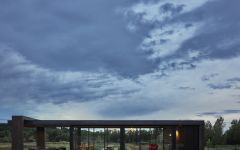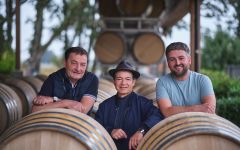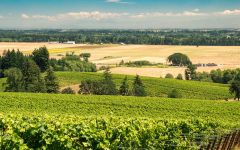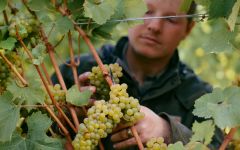Lingua Franca Bunker Hill Chardonnay 2017
-
Wine
Enthusiast -
Wine
Spectator



Product Details
Your Rating
Somm Note
Winemaker Notes
Bunker Hill has a richer texture in 2017, with lemon peel, savory and saline elements. The aroma is of white flowers and lemon peel. There is a fresh fruit quality of lemon and quince with alternating flavors of lemongrass, honeycomb, dried chamomile, and herbs quite nuanced. It has a mouth-filling texture, great tension, acidity, perfect ripeness and a mineral, lemony finish. Enjoy this with salmon and beurre blanc, flavored with Herbs de Provence or lemongrass and ginger. It also pairs well with classic lobster sauces, chicken with a morel cream sauce or halibut with a lightly herbed lemon butter.
Professional Ratings
-
Wine Enthusiast
Despite rather low finished alcohol, this is a fully ripened and complete wine. Spicy pineapple, bright citrus and a touch of white radish flavors combine through the midpalate, and aging in 20% new French oak rounds out the finish.
-
Wine Spectator
Svelte and elegantly polished, with sleek layers of apple, lemon curd and spicy lees that glide effortlessly on a lingering finish. Drink now.
Other Vintages
2022-
Robert
Parker
-
Jeb
Dunnuck -
Robert
Parker -
Wine
Spectator -
Wine
Enthusiast -
James
Suckling
-
Robert
Parker -
Wine &
Spirits -
Wine
Spectator -
Wine
Enthusiast
-
Wine
Spectator

One of the most popular and versatile white wine grapes, Chardonnay offers a wide range of flavors and styles depending on where it is grown and how it is made. While it tends to flourish in most environments, Chardonnay from its Burgundian homeland produces some of the most remarkable and longest lived examples. California produces both oaky, buttery styles and leaner, European-inspired wines. Somm Secret—The Burgundian subregion of Chablis, while typically using older oak barrels, produces a bright style similar to the unoaked style. Anyone who doesn't like oaky Chardonnay would likely enjoy Chablis.

One of Pinot Noir's most successful New World outposts, the Willamette Valley is the largest and most important AVA in Oregon. With a continental climate moderated by the influence of the Pacific Ocean, it is perfect for cool-climate viticulture and the production of elegant wines.
Mountain ranges bordering three sides of the valley, particularly the Chehalem Mountains, provide the option for higher-elevation vineyard sites.
The valley's three prominent soil types (volcanic, sedimentary and silty, loess) make it unique and create significant differences in wine styles among its vineyards and sub-AVAs. The iron-rich, basalt-based, Jory volcanic soils found commonly in the Dundee Hills are rich in clay and hold water well; the chalky, sedimentary soils of Ribbon Ridge, Yamhill-Carlton and McMinnville encourage complex root systems as vines struggle to search for water and minerals. In the most southern stretch of the Willamette, the Eola-Amity Hills sub-AVA soils are mixed, shallow and well-drained. The Hills' close proximity to the Van Duzer Corridor (which became its own appellation as of 2019) also creates grapes with great concentration and firm acidity, leading to wines that perfectly express both power and grace.
Though Pinot noir enjoys the limelight here, Pinot Gris, Pinot Blanc and Chardonnay also thrive in the Willamette. Increasing curiosity has risen recently in the potential of others like Grüner Veltliner, Chenin Blanc and Gamay.








